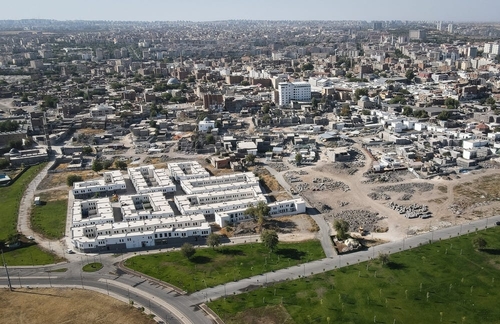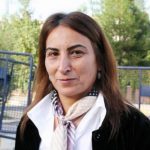Drone photo of newly-built apartments in Sur, Diyarbakır. (Photos: İnanç Yıldız)
Newly-planted trees line the blocks of newly-made homes in Sur, the historic center of Diyarbakır. A few older, larger trees stand in the adjacent fields created when many buildings were cleared away after sustaining heavy damage in a 2015-2016 conflict between Kurdish militants and Turkish armed forces. Sur hosted some of the most violent street clashes during the conflict.
Sitting beneath one of those older trees, I found Ali Çiçek, 66, a former resident of Sur’s Fatihpaşa neighborhood, who was wearing a traditional Diyarbakır shalwar, shirt and vest. He said the tree was one of the lucky few spared by bulldozers along with several registered historical buildings in the area. Then, he said the tree once provided shade for his courtyard and that his home once stood around it.
In 1978, Çiçek moved from a village in Diyarbakır to this neighborhood. He remained until conflict broke out in 2015 with the collapse of the Kurdish peace process and the region-wide conflict that followed. Now, Çiçek lives in an apartment complex in the Huzur Evleri district, a newer part of the city, but he still yearns for his old neighborhood.
“We came to Sur because there was no employment,” Çiçek told Turkey recap. “We lived well here. I mean, we used to know each other, know our neighbors. We used to visit each other, but now there are no such things where we live.”
“We left forty years behind, left it here,” he continued, remembering the day he left. “We couldn’t take anything with us. We just took the clothes we were wearing.”
The conflict displaced about 24,000 former Sur residents, changing the neighborhood’s social fabric while ongoing reconstruction remakes its physical character. Both locals and conservationists have long expressed concerns over the fate of post-conflict Sur, where history dates back through many centuries and civilizations, as evidenced by its many hans, hamans, mansions, mosques and churches.
On February 1, 2016, then-PM Ahmet Davutoğlu famously responded to such concerns by saying: “Certified Diyarbakır houses, mosques, churches and hans will be restored without damaging the architectural texture of Diyarbakır. We will build Diyarbakır, Sur in such a way that it will become a place everyone wants to see with its architectural texture, just like Toledo,” referring to the city in Spain.
Yet the rebuilding process has frayed the neighborhood’s texture at the seams. Six years after Davutoğlu’s speech, most certified historical buildings have been preserved or are undergoing renovation, but large parts of Sur were razed as part of a nationwide urban renewal project, accelerated locally by conflict-related damage – at times with devastating results for residents and world heritage.
Ali Çiçek sits under a tree that used to be in his home’s courtyard.
Architectural texture
Ferit Kahraman, co-chairman of Diyarbakir’s Chamber of Architects, said reconstruction efforts in Sur could not be compared to conservation work in Toledo. Highlighting one example, he noted the use of reinforced concrete instead of the dark gray basalt stone seen in the neighborhood’s older structures, as well as in the fortress walls that encircled the historic quarter.
When Kahraman sees the new structures, he believes it would have been better to leave a large empty area. Kahraman likened the uniformity of the new residential buildings to a prison, saying the project designs must have been contracted to a single person who was unaware of local culture.
He continued, noting Sur is known for its narrow streets, which provide shade and cool breezes in hot summer months, but the newly-made streets are wide and provide no such relief. “The construction process also destroyed the remains of old structures or traces of foundations,” Kahraman said.
According to Kahraman, the structures built after the conflicts were given to groups supportive of the Turkish government rather than all citizens. And while urban renewal projects seem to have stopped for now, he said it’s only a matter of time before we see more buildings that don’t fit with the neighborhood.
“About a year ago, the Sur Municipality, which is under the management of a [state-appointed] trustee, started the tender processes for the demolition of hundreds of buildings in Sur classified as derelict, and took initiatives to destroy the street texture in this way,” Kahraman said.
Drone photo of a separate block of new apartments in Sur.
Compensation and expropriation
Most of the 20,000 residents that lived in Sur’s Cevatpaşa, Fatihpaşa, Hasırlı, Cemal Yılmaz, Savaş and Dabanoğlu neighborhoods, were displaced and have relocated to other districts following the 2015-2016 conflict.
While many residents wanted to reclaim or rebuild their homes and workplaces in Sur, most eventually sought to settle property disputes through state compensation to cover their losses. Some were compensated for their homes, while others took state credit to finance a new home purchase through the Housing Development Administration of Türkiye, known as TOKİ.
Lawyer İhsan Aslan said expropriation is normally far beyond the norm, but not for Sur. Noting some courts caused grievances by not basing property compensation on free market prices, Aslan said it was wrong to pursue new constructions through expropriation in the first place.
“Instead, there should have been a development plan based on on-site renewal,” Aslan told Turkey recap. “If this approach was followed, there would have been no possibility to drive people out of their homes.”
“There have been serious injustices,” Aslan added.
He continued, saying the issue could not be brought to the judiciary because many citizens did not initially contact a lawyer regarding their rights.
“It is a mistake not to give priority and privilege to the residents of Sur,” Aslan said. “Positive discrimination should have been implemented [in their favor].”
A lone, historic building stands near new apartments in Sur.
Effects on local shops
According to Aslan, the area across from the Grand Mosque is the most valuable part of Sur today. Yet apart from lingering questions over the rightful ownership of adjacent buildings, many concerns have also come from rental agreements and the management of those properties.
Shops in the nearby commercial area, next to the Four-Legged Minaret, were auctioned off earlier this year to the highest bidders. Among the new shops, which have been operating here since late summer, rents currently range from 6,500 liras to 70,000 liras a month
One of these businesses is a Maraş ice cream shop operated by Nermin Teke, 38, and her family, who moved from Kahramanmaraş to Diyarbakır 1.5 years ago. In addition to running a carpet cleaning shop, she opened their first store to promote Maraş ice cream in Diyarbakır.
She said she bought a store in front of the Four-Legged Minaret because she believed its value would grow in the future.
According to Teke, the previous shop’s rent used to be 5,000 liras a month, but it increased to 30,000 liras for the new place they opened. Separately, the monthly electricity bill was 18,000 liras. She said she can only pay the staff wages with the store’s daily revenue, adding the shopkeepers in the area are facing dire constraints with their current expenses.
“What’s going on? You take out a loan, you withdraw from the shopkeeper’s guarantee credit, you withdraw from the bank, you withdraw from there, you withdraw from here, you become incapacitated,” Teke told Turkey recap. “This is not just for us. The shopkeepers we know get together and talk about it. No one is happy with how things are.”
She added she was afraid when she first came to Diyarbakır in 2021, but has since settled in.
“Even though they didn’t know us, they did their best even though we were strangers,” Teke said. “They gave us great support, everyone was helpful. I like this place.”
Another business near the Four-Legged Minaret, is a house with a garden, which was built with basalt stone, owned by the Chaldean Church and put into operation in 2013 as the “Diyarbakır Breakfast House.”
The house was closed down during the conflict. Although there was no curfew on the street where the venue is located, it remained de facto closed for security reasons until April 2018, when it reopened. The business has yet to reach the revenue flow it had before 2015.
“Before the ban, our place was a popular venue. We could carry our own weight,” said Merthan Anık, 47, one of the managers.
He continued, “We have been having a lot of trouble recently. We have a situation in limbo. In the section up to the Four-Legged Minaret, you see the old Diyarbakır, Sur. Five meters from where we live, you enter a city made from scratch with completely different freak buildings. We are one of the remaining certified structures in this area. I can’t say it’s getting a lot of attention right now.”
Anık said the monthly electricity bill is 17,500 liras, which means the business can barely cover its expenses with the current daily revenue of 4,000-5,000 liras. Noting business is not going well, Anık attributes the cause to the lack of a tourism policy in the city.
He also said locals did not assimilate, embrace and accept the new situation, adding some tradesmen were able to recover, but businesses could not and some had to sell their places.
“They left, they couldn’t handle the process,” Anık told Turkey recap. “The shopkeepers whose shops were destroyed [were reimbursed through] cash deposits in their bank accounts and no other opportunity was given. They were told: ‘you will take the money and leave’.”
He continued, “The shopkeepers are very uncomfortable with this situation. Outside businesses that have nothing to do with this place have opened in the place where [locals] have been doing business for years, and [locals] cannot benefit from even a speck of it.”
A woman walks on a street in a rebuilt area of Sur.
‘We can’t afford to come back’
Ali Çiçek, who I found sitting under the old tree, said he received rent support for a year after leaving Sur. These days, he gets by on a monthly pension of 4,000 liras and the salaries of his family members.
“We were able to make a living here,” he said. “There was no natural gas, no transport fees, no building fees. Now it’s all there.”
He said, the minimum rent in the Huzur Evleri area, where Çiçek currently lives, is 2,500-3,000 liras. That’s far less than rents for new homes in Sur, which have effectively priced him out of his old neighborhood.
“People like me are now tenants,” Çiçek said. “I came here, took a breath, nothing else. We can’t afford to come back here, we can’t buy houses, the houses in this district are expensive. Life is hard here now. Because everywhere is a shop, no one can live here. I can’t believe it.”
Çiçek went on to compare his current life in high-rise apartments to the one he led in Sur for nearly 40 years.
“When our house was here, four-five people would drink tea on our street. But now, no one in the [apartment] building knows anyone,” Çiçek said. “We stayed here for 40 years. What does 40 years mean, it means a lifetime. We knew all the people on the street in the neighborhood. There was no one we didn’t know.”
He continued, “There were historical houses, most of them were demolished … The bottom of our house was normal Diyarbakır stone, and the upper floor was brick. They could have restored our houses but they did not.”
“When they brought us here for a damage assessment, I wouldn’t have known where the house was if it wasn’t for this tree. At that time, they had already demolished them all.” (İY/VK)
This report was produced by Turkey recap with support from the Heinrich Böll Foundation in Turkey and the IPS Communication Foundation.
Source:Bianet



